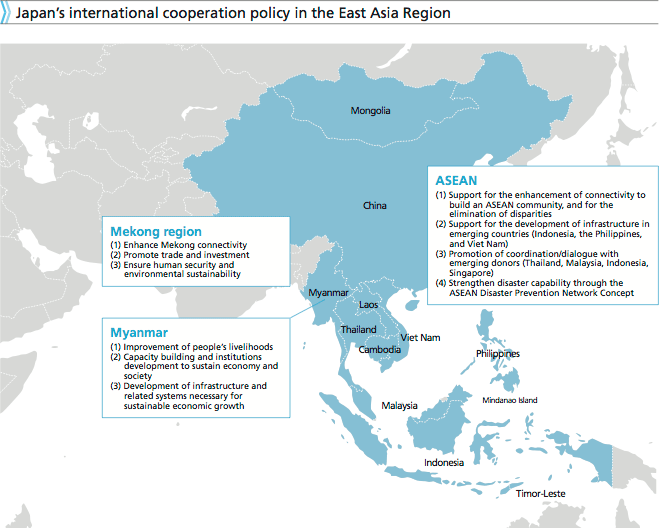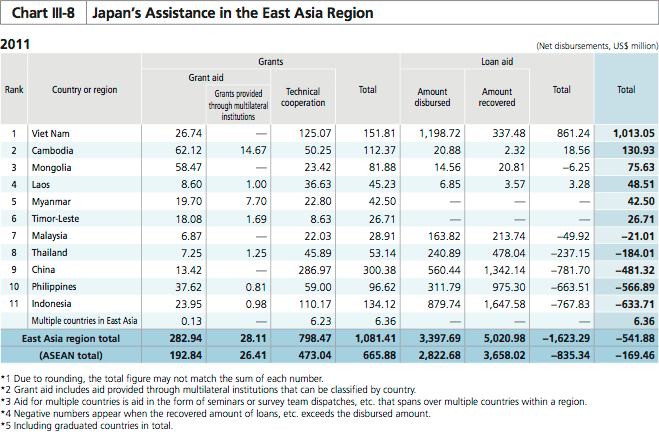Japan's Official Development Assistance White Paper 2012
1. East Asia
East Asia consists of a variety of nations: countries such as Republic of Korea and Singapore, which have attained high economic growth and have already shifted from aid recipients to donors; least developed countries (LDCs) such as Cambodia and Laos; countries such as China, which still has internal disparities despite its dramatic economic growth; and countries such as Viet Nam, which is in the process of transitioning from a centrally planned economy to a market economy. Japan has close relationships with these countries in all aspects of politics, economy, and culture, so the development and stability of the region significantly impacts the security and prosperity of Japan as well. From this perspective, Japan is engaging in assistance activities, responding to not only the diverse socio-economic circumstances of East Asian countries but also to the changes in the type of aid needed.
<Japan's Efforts>
Japan has contributed to the remarkable economic growth in East Asia by implementing economic cooperation that combines ODA with trade and investment, including the improvement of infrastructure, development of systems and human resources, promotion of trade, and revitalization of private investment. Currently, Japan is aiming to further enhance open regional cooperation and integration while sharing basic values, to promote mutual understanding, and to maintain consistent regional stability. Therefore, Japan has made efforts to respond proactively to transnational problems such as natural disasters, environment and climate change, infectious diseases, terrorism and piracy and others, in parallel with the assistance for developing infrastructure to date. Japan is also working to promote mutual understanding through large-scale youth exchanges, cultural exchanges, and projects to disseminate Japanese language education.
Although the impact of the global financial and economic crisis which started in 2008 has largely been overcome in East Asia, in order for Japan and other Asian countries to achieve further economic prosperity, it will be important to assist Asia to become "a center of growth open to the world." Accordingly, Japan is providing assistance to strengthen Asia's growth and to expand domestic demand in each country.
In April 2009, Japan announced that it would provide up to ¥2 trillion of ODA as a specific measure to assist the Asian region.(Note 16) In light of that pledge, Japan is consistently providing support for infrastructure development, assistance towards socially vulnerable people, building low-carbon societies, and human resource development.
●Support for Southeast Asia
Members of the Association of Southeast Asian Nations (ASEAN)(Note 17) aim for building of the ASEAN community by 2015. Japan has continued to assist the enhancement of ASEAN connectivity and in narrowing the development gap within ASEAN. In particular, for the Mekong countries(Note 18), which are late-joining members of ASEAN, providing support is important from the standpoint of reducing intraregional disparities as well.
The first-ever Mekong-Japan Summit Meeting was held in November 2009, with representatives from participating countries gaining a shared recognition regarding the Establishment of a New Partnership for the Common Flourishing Future and strengthening measures based on three pillars: (i) comprehensive development of the Mekong region; (ii) environment and climate change (launch of the "A Decade toward the Green Mekong" initiative), and overcoming vulnerability; and (iii) expansion of cooperation and exchanges. To promote these efforts, Japan committed that it would expand ODA, particularly to Cambodia, Laos, and Viet Nam, and the entire Mekong region, with more than ¥500 billion of ODA in the next three years.
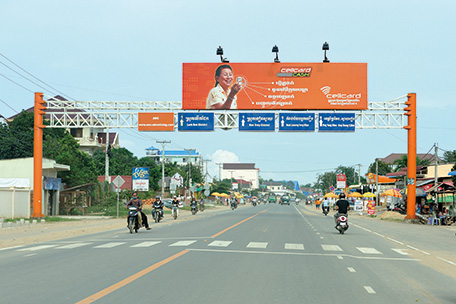
Construction is complete on the new, improved Cambodian National Route 1. (Photo: Koji Sato/JICA)
In addition to this consistent support, leaders at the Fourth Mekong-Japan Summit Meeting in April 2012 adopted the new Tokyo Strategy 2012 for Mekong-Japan Cooperation based on three pillars: (i) enhancing Mekong Connectivity; (ii) developing together; and (iii) ensuring human security and environmental sustainability. Japan announced that it would provide ¥600 billion of ODA over three years starting in 2013 to make sure that the Tokyo Strategy steadily comes to fruition. Japan also adopted the Mekong-Japan Action Plan that contains specific actions and measures to realize the Tokyo Strategy 2012 at the Fifth Mekong-Japan Foreign Ministers’ Meeting in July 2012 in Phnom Penh, Cambodia.
In addition to promoting such efforts, Japan is providing support in promoting ASEAN economic integration, with poverty reduction and narrowing the development gap within ASEAN. Further, at the ASEAN Summit Meeting held in October 2010, ASEAN adopted the Master Plan on ASEAN Connectivity* aiming at intensifying physical connectivity, institutional connectivity and people-to-people connectivity in the region. Japan is utilizing ODA and public-private partnership (PPP) to provide proactive assistance to put the Master Plan into action.
At the ASEAN-Japan Summit in November 2011, Japan announced a "List of flagship projects for enhancing ASEAN Connectivity", with fund procurements utilizing public funds from ODA and the Japan Bank for International Cooperation (JBIC) with consideration given to ways of mobilizing private-sector funds. Moreover, Japan has been contributing to peacebuilding efforts, such as intensive support for the conflict affected areas in Mindanao in the Philippines, and assistance for nation-building in Timor-Leste.
Japan has strengthened its partnership with the Asian Development Bank (ADB), which works on a variety of regional cooperative initiatives in the Asia region. For example, Japan contributed up to $25 million over five years to the ADB for trade facilitation in ASIA. Japan has also strengthened its partnership with the Economic Research Institute for ASEAN and East Asia (ERIA), an international research organization in East Asia, including cooperation toward implementation of the Comprehensive Asian Development Plan and the Master Plan on ASEAN Connectivity.
Further, on the financial front in particular, Japan has taken the lead in implementation of the Chiang Mai Initiative (CMI)* within the ASEAN+3 (Japan, China, Republic of Korea) framework. This initiative is designed to prevent a chain reaction of currency crises and its expansion by means of providing short-term foreign currency financing for countries in which critical circumstances have arisen, such as obstacles arising in their foreign currency payments due to precipitous outflows of capital. In March 2010, the Chiang Mai Initiative Multilateralization Agreement came into effect, changing the former CMI framework, which was based on an agreement between the related authorities of two countries to an agreement between multiple countries, in order to make support faster and smoother. This enabled faster response to the international balance of payments within the ASEAN+3 regions as well as to the difficulties with liquidity in short- term financing, thereby strengthened the capacity to deal with the risks and challenges of an expanding global economy.
Furthermore, the ASEAN+3 Finance Ministers and Central Bank Governors' Meeting in May 2012 agreed to double the size of the CMIM from $120 billion to $240 billion and to add crisis prevention facility to the existing crisis management facility. They also agreed on the decision to enhance regional financial cooperation by enhancing the organizational capacity of the ASEAN+3 Macroeconomic Research Office (AMRO)*, an institution that monitors and analyzes the regional economy, and hastening its preparation to become an international organization. These efforts are expected to contribute to both regional and global financial and economic stability.
Further, in addition to the CMI, Japan has taken the lead in efforts to foster the bond market of ASEAN+3. In particular, in May 2010, the decision was made to establish the Credit Guarantee and Investment Facility (CGIF) as an ADB trust fund, to guarantee bonds issued by the companies of ASEAN+3 in local currencies, with initial capital of $700 million. Japan has contributed to CGIF $200 million through JBIC.
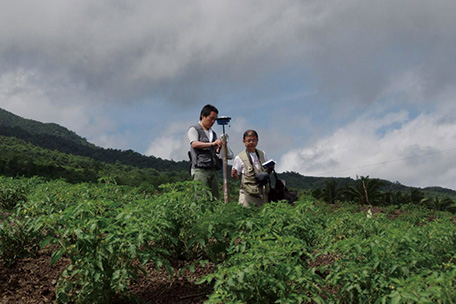
An expert taking GPS measurements on Mayon Volcano in the Philippines (Photo: JICA)
- *Master Plan on ASEAN Connectivity
- A plan adopted at the October 2010 ASEAN Summit to enhance connectivity towards building of the ASEAN Community by 2015. This enhancement focuses on 3 types of connectivity: physical connectivity (transport, ICT, energy networks, etc.), institutional connectivity (liberalization and facilitation of trade, investment, services, etc.), and people-to-people connectivity (tourism, education, culture, etc.).
- *Chiang Mai Initiative (CMI)
- An agreement for local financial cooperation adopted by ASEAN+3 (Japan, China, Republic of Korea). It is a mechanism to assist countries in East Asia that have experienced an economic crisis and suffer a dramatic shortage of foreign currency, by exchanging dollars held as a foreign reserve by each Asian country into the currency of that country, to make up for shortages in foreign currency.
- *ASEAN+3 Macroeconomic Research Office (AMRO)
- The establishment of AMRO was agreed at the ASEAN+3 Finance Ministers Meeting in May 2010 in Tashkent based on the recognition of the importance of improving regional economic surveillance to make Chiang Mai Initiative decision-making easier and more efficient. The office was established in Singapore in April 2011.
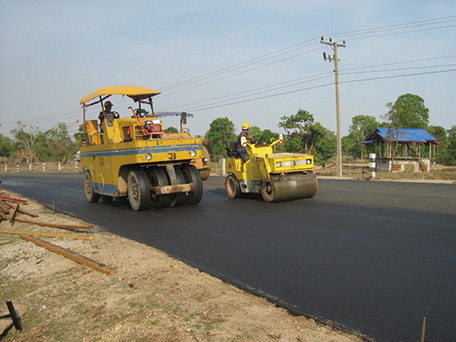
A project to improve roadway maintenance capabilities in Laos. Repairs were done in badly damaged areas. (Photo: JICA/International Development Center of Japan/Oriental Consultants)
Note 16: Asian economy growth concept
Note 17: ASEAN countries: Brunei, Cambodia, Indonesia, Laos, Malaysia, Myanmar, Philippines, Singapore, Thailand, and Viet Nam
Note 18: Mekong countries: Cambodia, Laos, Myanmar, Thailand, and Viet Nam
●Malaysia
Development Project for Malaysia-Japan International Institute of Technology (MJIIT)
ODA Loan (December 2011 - Present)
Since 1982, Malaysia has employed a Look East Policy* to learn from Japanese business ethics, management philosophies and successful experiences and connect them to its own development. MJIIT is a higher education institute that offers a Japanese-style engineering education and was established as the culmination of the Look East Policy. Japan helps MJIIT procure materials and equipment for education and research and improve curriculum. In collaboration with 24 Japanese universities, Japan also provides cooperation by helping develop curricula and dispatching Japanese educators.
Malaysia has become one of priority countries for Japanese companies looking to expand overseas, with over 1,400 Japanese companies having already done so. MJIIT's development of people with advanced knowledge is expected to contribute to the development of Malaysia and help Japanese companies in Malaysia secure local human resources.
(As of December 2012)
* Look East Policy: A concept aimed at developing Malaysia socioeconomically by learning from Japanese and Korean work ethics, management philosophies and Japan's successful experiences. Malaysian Prime Minister Mahathir advocated the policy in 1981. The Malaysian government began sending exchange students and trainees to Japan in 1982. About 14,000 Malaysians have studied in Japan to date.

New campus building completed in February 2012. (Photo: JICA)
●Relations with China
Since 1979, ODA to China has been provided for the development of infrastructure in coastal areas, environmental issues, improvement in basic human needs such as health and medical care, and the development of human resources, thereby contributing to the steady development of the Chinese economy. Japan’s assistance has also played a significant role in promoting and maintaining the Reform and Opening Up Policy of China. The majority of this assistance was provided to China in the form of ODA loans. In addition to supporting the development of the economic relationship between Japan and China, this ODA has functioned as a fundamental pillar of the multilayered Japan-China relationship. On a variety of occasions, the Chinese side including the Chinese summit level has expressed gratitude. In light of China's remarkable economic development in recent years, both countries commonly recognized that new disbursement of ODA loans to China would come to an amicable conclusion by the time of the 2008 Beijing Olympics. Such new disbursement ended with the signing of Exchanges of Notes for six projects in December 2007.
At present, China has developed economically, and has seen an increase in its technological level, so aid through ODA has already fulfilled its role to a certain degree. On the other hand, the people of both Japan and China face many common strategic issues including global issues such as environmental problems, infectious diseases, and other problems that have a direct impact on Japan as well. During Chinese President Hu Jintao's visit to Japan in May 2008, the two countries issued the "Joint Statement between the Government of Japan and the Government of the People's Republic of China on Comprehensive Promotion of a Mutually Beneficial Relationship Based on Common Strategic Interests" to confirm that the nations would place particular emphasis on cooperation in the fields of energy and the environment, and made a joint statement on climate change. In addition, along with supporting each other's peaceful development between Japan and China, it is important to deepen mutual understanding between the people of the two countries. In the current Japan-China relationship that aims to achieve and deepen "mutually beneficial relationship based on common strategic interests," it has become important to build a new type of cooperation.
In light of these circumstances, implementation of purely exchange projects through ODA have concluded, and ODA for China is being limited to promoting mutual understanding at the grass-roots level and working to deal with shared challenges faced by both countries (for example, measures against pollution, yellow sand, and infectious diseases that cross into Japan, as well as creating systems and standards to increase the predictability of companies that enter the Chinese market), and to areas that benefits to Japan.
